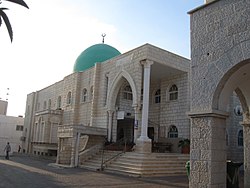Kafr Bara
Kafr Bara
|
|
|---|---|
| Hebrew transcription(s) | |
| • ISO 259 | Káper Báraˀ |
| • Also spelled | Kafar Bara (official) Kfar Bara (unofficial) |

Mosque in Kafr Bara, 2010
|
|
| Coordinates: 32°7′50″N 34°58′19″E / 32.13056°N 34.97194°ECoordinates: 32°7′50″N 34°58′19″E / 32.13056°N 34.97194°E | |
| Grid position | 147/170 PAL |
| District | Central |
| Government | |
| • Type | Local council |
| Area | |
| • Total | 9,387 dunams (9.387 km2 or 3.624 sq mi) |
| Population (2015) | |
| • Total | 3,354 |
| Name meaning | Khirbet Kafr Bara, "The ruin of the village of Bara" |
Kafr Bara or Kfar Bara (Arabic: كفر برا; Hebrew: כַּפְר בַּרָא) is an Israeli-Arab local council in Israel's Central District. The small town, located near the Green Line, is often considered a part of the Little Triangle along with Kafr Qasim and Jaljulia. In 2015 its population was 3,354.
Pottery and glass dating from the Roman period (second century CE) and early Byzantine period (fourth century and beginning of fifth century CE), have been found in a burial cave at Kafr Bara. Archaeological excavations have revealed remains, apparently from a rural settlement from the Byzantine and Early Islamic periods (sixth–ninth centuries CE).
In 1517, the village was included in the Ottoman Empire with the rest of Palestine, and in the 1596 tax-records it appeared located in the Nahiya of Jabal Qubal of the Liwa of Nablus. It had a population of 20 Muslim households, who paid taxes on wheat, barley, summercrops, and goats and/or beehives.
At the 1931 census of Palestine, conducted by the British Mandate Kafr Bara had 95 inhabitants, all Muslims, in a total of 19 houses.
...
Wikipedia

